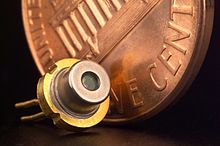This article's lead section may be too short to adequately summarize the key points. (November 2016) |
 | |
| Type | semiconductor, light-emitting diode |
|---|---|
| Working principle | semiconductor, carrier generation and recombination |
| Invented | Robert N. Hall, 1962; Nick Holonyak, Jr., 1962 |
| Pin configuration | Anode and cathode |



A laser diode (LD, also injection laser diode or ILD or semiconductor laser or diode laser) is a semiconductor device similar to a light-emitting diode in which a diode pumped directly with electrical current can create lasing conditions at the diode's junction.[1]: 3
Driven by voltage, the doped p–n-transition allows for recombination of an electron with a hole. Due to the drop of the electron from a higher energy level to a lower one, radiation is generated in the form of an emitted photon. This is spontaneous emission. Stimulated emission can be produced when the process is continued and further generates light with the same phase, coherence, and wavelength.
The choice of the semiconductor material determines the wavelength of the emitted beam, which in today's laser diodes range from the infrared (IR) to the ultraviolet (UV) spectra. Laser diodes are the most common type of lasers produced, with a wide range of uses that include fiber-optic communications, barcode readers, laser pointers, CD/DVD/Blu-ray disc reading/recording, laser printing, laser scanning, and light beam illumination. With the use of a phosphor like that found on white LEDs, laser diodes can be used for general illumination.
- ^ Larry A. Coldren; Scott W. Corzine; Milan L. Mashanovitch (2 March 2012). Diode Lasers and Photonic Integrated Circuits. John Wiley & Sons. ISBN 978-1-118-14817-4.